Section 1: – Advanced Shipping (Warehouse)
The shipping process with Warehouse is also called as Advanced shipping process, where two different stations are used as Packing Station and Shipping Station.
Pack Order and Closing Process by Packer (From Packing Station)
If the small packages that are being shipped for the Sales Orders are created in Business Central, then the Pack Order form is used to process the packages.
The Pack Order form can be accessed in the below way:
We can open the Pack Order from two places in the Smart Shipping. They are: –
- Smart Shipping Menu -> Pack Order
- Smart Shipping Menu -> Shipping List -> Select the Order Line -> Select Pack Order in the Function Menu
The General Tab fields in the Pack Order form:

Short Description for the General Tab Fields in Pack Order form:
| Fields | Comments |
| Document Type | This field is used to specify Document Type. Valid values are: Sales Order, Sales Invoice, Purchase Return Order, and Purchase Credit Memo |
| Source ID | This field is used to specify Document Type ID. |
| Shipping Agent Code | This field is used to specify the shipping agent code. Valid Values are FEDEX, UPS, USPS, ENDICIA, and SPEEDEE. |
| Shipping Agent Service Code | This is field is used to specify the shipping agent service name. This depends upon the shipping agent code. |
| Ship-to Name | Specifies the Ship to Name. It is automatically populated when the user enters the order number in the Order Number Box. |
| Ship-to Address | Specifies the Ship to Address. It is automatically populated when the user enters the order number in the Order Number Box. |
| Ship-to Address2 | Specifies the Ship to Address2. It is automatically populated when the user enters the order number in the Order Number Box. |
| Ship-to City | Specifies the Ship to City. It is automatically populated when the user enters the order number in the Order Number Box. |
| Ship-to State/Zip Code | Specifies the Ship to Stage and Zip Code. It is automatically populated when the user enters the order number in the Order Number Box. |
| Ship-to Country Code | Specifies the Ship to Country. It is automatically populated when the user enters the order number in the Order Number Box. |
| Ship-to Phone No | Specifies the Ship to Phone. It is automatically populated when the user enters the order number in the Order Number Box. |
| Ship-to Contact | Specifies the Ship to Contact Person. It is automatically populated when the user enters the order number in the Order Number Box. |
| Residential | Specifies whether the Ship-to Address is residential or not. |
| Package Count | Specify the total number of packages in the shipment. |
| Package No | This field is automatically filled when the package is created. It specifies the current package number of the shipment. It is updated when the Create Package option in the Functions menu is selected. Before selecting the Create Package option, you must enter the total packages in the shipment in the Package Count field. |
| Scale Weight | Specifies the current package weight. |
| Package of | It will show the sequence number of the Packages in the shipments. For example: If the current Package is 2nd then it will show as 2 of 5. 2 is Sequence No. and 5 is Package Count. |
| Identical Packages | If users want to create identical packages, this option must be checked. The system will create and close multiple packages which are exactly similar to the first package based on the Qty. to Pack on the Pack Order lines. |
| Actual Length | This field specifies the Length of the package. Defined Length is used if this field is left blank. |
| Actual Width | This field specifies the Width of the package. Defined Width is used if this field is left blank. |
| Actual Height | This field specifies the Height of the package. Defined Height is used if this field is left blank. |
| Package Type | Indicates the type of Package. Valid values are: Customer Package10kg Box25kg BoxFedEx Box (FedEx only)FedEx Envelope (FedEx only)PakTubeUPS Letter (UPS only)UPS Express Box (UPS only)PalletSmall Express Box (UPS only)Medium Express Box (UPS only)Large Express Box (UPS only) |
The Dimensions Tab fields in the Pack Order form:

Short Description for the Dimensions Tab Fields in Pack Order form:
| Fields | Comments |
| Defined Length | This is the Length as defined in the Item Unit of Measure |
| Defined Width | This is the Width as defined in the Item Unit of Measure |
| Defined Height | This is the Height as defined in the Item Unit of Measure |
| Defined Package Value | This is the sum of values (Amount) of all the lines in the package. |
| Defined Gross Weight | This is the sum of the Gross Weights of all the lines in the package. |
| Dimension Unit of Measure | Identifies the unit of measure associated with a Dimension value. |
| Weight Unit of Measure | Identifies the unit of measure associated with a weight value. See the list of enumerated types for valid values. Valid values are: • KG • LB |
| Drop off Type | Identifies the method by which the package is to be tendered to FedEx. This element does not dispatch a courier for package pickup. |
| Actual Package Value | This specifies the Total Value of the package. A defined value is used if this field is left blank. |
| Defined Net Weight | This is the sum of Net Weights of all the lines in the package. |
| Shipping Insurance | Specifies whether the shipping insurance is requested or not. |
| Free Shipping | Specify whether the shipping costs displayed on the sales documents are to charge to the customer. |
| Auto Return | Specifies whether the order is an auto return. |
Now to proceed with the packing Process from the packing Station below are the Steps: –
Step1: – When the user enters the Order Number manually or scans in the textbox, then shipment order details are displayed in the Pack Order as shown in the below screenshots: –
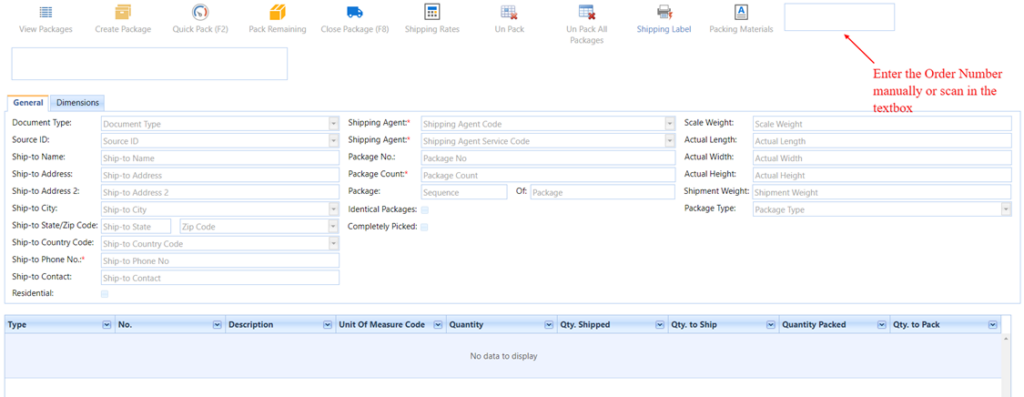
The sales line order items with qty. to ship > 0 and available to pack are displayed in the table format below in the Pack Order form. After the order number is entered in the Order No box, the order items will look similar to the screen below.

Order Items fields explanation.
Quantity specifies the item quantity on the Sales Order. It is automatically filled from the Sales document.
Qty. Shipped specifies the shipped quantity of the item in cases where the user already shipped the order.
Qty. to Ship specifies the quantity of an item for which warehouse pick is registered and is available for packing.
Quantity Packed specifies the item quantity packed in the previous packages in this shipment.
Qty. to Pack specifies the item quantity to Pack in the new package which is being created.
This is the only editable field in the sales order line items screen and the remaining fields are non-editable.
Step2: – The Next Step is to Create and close the package from the packing Station which we can do in two ways: –
- Quick Pack: – This is used when we need to create a single Package for all the Item Lines with the Qty. to Ship available as shown in the below screenshot: –

After you click the Quick Pack(F2) the Quantity Packed, Package No., Package Count, and the package of Field will be updated on the Pack Order Screen as shown in the below screenshot: –
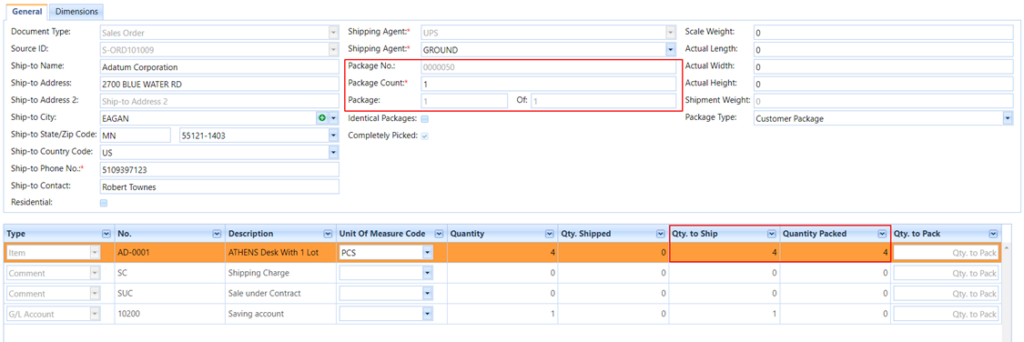
The first package is now created and the Quantity Packed is updated on the Pack Order Lines With the entered quantity in Qty. to Pack. The form will now look as below: –
- Now after Quick Pack you have to close the package. Click on Functions Menu -> Select the Close Package Menu or else press Keyboard Function key F8.
2. Create Package: – This is used if the user wants to create multiple packages or identical packages
A. Multiple Packages: –
To Create Multiple Packages the package count should be more than one.
For example, if you want to create 2 packages in a shipment then please follow the below process: –
- Enter Package Count, Package Weight, and Qty. to Pack for the lines to be packed. And then Select Function Menu -> Create Package.

- Now close the 1st created package. Click on Functions Menu -> Select the Close Package Menu or else press Keyboard Function key F8
- After Closing the 1st package, we have to create and close the 2nd Package for the remaining Quantity following the below process: –
- Enter the Remaining Quantity in Qty. To Pack and then Select Function Menu -> Create Package.
- We can also click on Pack remaining from Functions Menu which will create the package for the remaining Quantity and then click on close Package Menu to close the package.
Note: – Pack remaining can be used for the last Sequence No. only.
B. Identical Packages: – If the user wants to create Identical Packages, the package count should be more than one. For example, if you have to process two identical packages, the package count should be entered as 2.
- Enter package weight and Qty. to Pack for the package. Click on Function Menu -> Create Package.
The first package is now created and the Quantity Packed field of the lines is updated. The form looks as below.

- Select the Identical Packages field. Before creating the package, we need to select the ‘Identical Package’ field and fill the remaining fields to create a package and Click on Functions Menu -> Select the Close Menu or else press Keyboard Function key F8.
The Other Menu options in Pack Order Screen are:
Un Pack: This function is used to delete the Package. The request regarding the cancellation of the package is sent to the carrier and upon a successful response, the package is deleted.
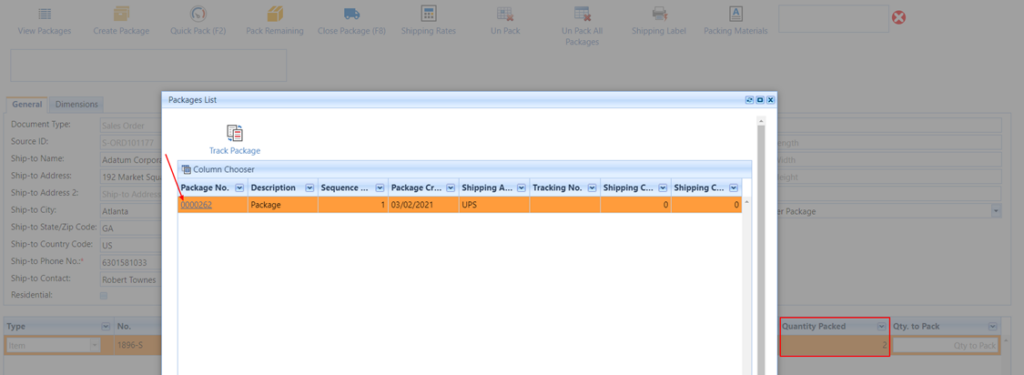
Un Pack All Packages: This function is used to delete all the packages in the shipment. The request regarding the cancellation of complete shipment is based on the shipping agent code carrier and upon the successful response, each package in the shipment is deleted.
Shipping Labels: This function is used to print the Package Content labels after the package is closed from the package station.
Packing Materials: This function is used to calculate the packing materials used for each package. Please click this button after the closing of each package to enter Item No.
At the end of the day, we can calculate the total No. of Ship packing Materials or boxes used for shipment.
Before entering Item No. here, it should be created as an item in Business Central.
Below is the screenshot for the Packing Materials Menu:
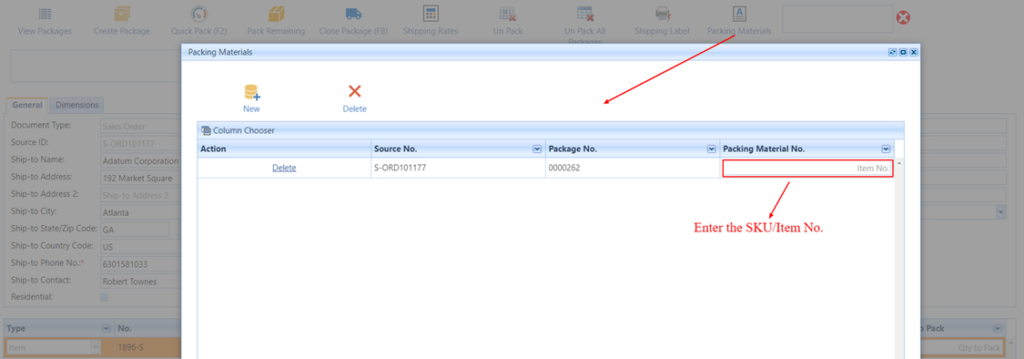
Processing Order by Shipper
Now the Packer functionality is done. We will move to Shipping Station and will see how to perform the next steps.
Step1: Login to Smart Shipping with the Shipping User Credential and then click on the packing list which shows a list of all the packages closed by the Packer as shown in the below screenshot: –
Packages forms

Step2: Select the Package from the package List, which will navigate to the package card page as shown in the below screenshot: –
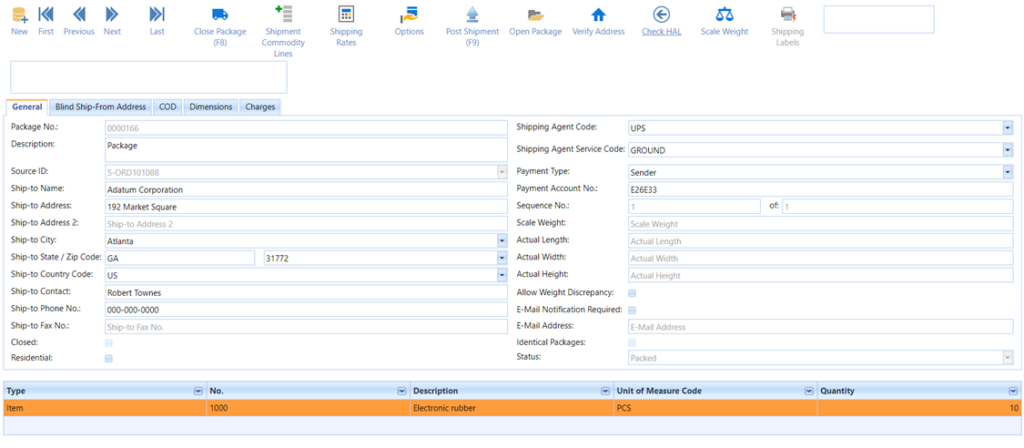
Short Description for the General Tab Fields in Package card form:
| Fields | Comments |
| Package No. | This field is used to specify the Current package No. |
| Description | This field is used to specify the Package Description in short. |
| Source ID | This field is used to specify Order ID. |
| Ship-to Name | Specifies the Ship to Name. It is automatically populated when the user enters the order number in the Order Number Box. |
| Ship-to Address | Specifies the Ship to Address. It is automatically populated when the user enters the order number in the Order Number Box. |
| Ship-to Address2 | Specifies the Ship to Address2. It is automatically populated when the user enters the order number in the Order Number Box. |
| Ship-to City | Specifies the Ship to City. It is automatically populated when the user enters the order number in the Order Number Box. |
| Ship-to State/Zip Code | Specifies the Ship to Stage and Zip Code. It is automatically populated when the user enters the order number in the Order Number Box. |
| Ship-to Country Code | Specifies the Ship to Country. It is automatically populated when the user enters the order number in the Order Number Box. |
| Ship-to Phone No | Specifies the Ship to Phone. It is automatically populated when the user enters the order number in the Order Number Box. |
| Ship-to Contact | Specifies the Ship to Contact Person. It is automatically populated when the user enters the order number in the Order Number Box. |
| Residential | Specifies whether the Ship-to Address is residential or not. |
| Shipping Agent Code | This field is used to specify the shipping agent code. Valid Values are FEDEX, UPS, USPS, ENDICIA, and SPEEDEE. |
| Shipping Agent Service Code | This is field is used to specify the shipping agent service name. This depends upon the shipping agent code. |
| Payment Type | Describe the type of payment. Valid values are: SenderRecipientThird-PartyCollectAccount Consignee Billed |
| Payment Account No | This field has the Account Number of the payer. So, this depends on the Payment Type. |
| Sequence No. | This field specifies the total packages Created from the package station. For Example – 1(Package Count) OF 3 (Total Packages.) |
| Scale Weight | Specify the current package weight. |
| Actual Length | This specifies the Length of the package. Defined Length is used if this field is left blank. |
| Actual Width | This specifies the Width of the package. Defined Width is used if this field is left blank. |
| Actual Height | This specifies the Height of the package. Defined Height is used if this field is left blank. |
| Allow Weight Discrepancy. | This field is used to specify if users want to check the Package weight discrepancy. |
| E-Mail Notification Required | Specifies whether shipment notification is sent or not |
| Email Address | Specifies the shipment notification email address |
| Identical Packages | If this field is checked from the packing station, then upon closing of the first identical package, it will automatically close all the other identical packages in the order shipment group. |
| Status | This field is used to specify the status of the package. Valid values are: – Closed: – Specifies that package is shipped and closed in Pack Order. Packed: – Specifies that package is Packed from the Packing Station. Shipped: – Specifies that the package is closed or shipped from the Shipping station. Rated: – Specifies that shipping rates are updated for the Package. |
The Blind Ship-From Tab fields in the Package card form:
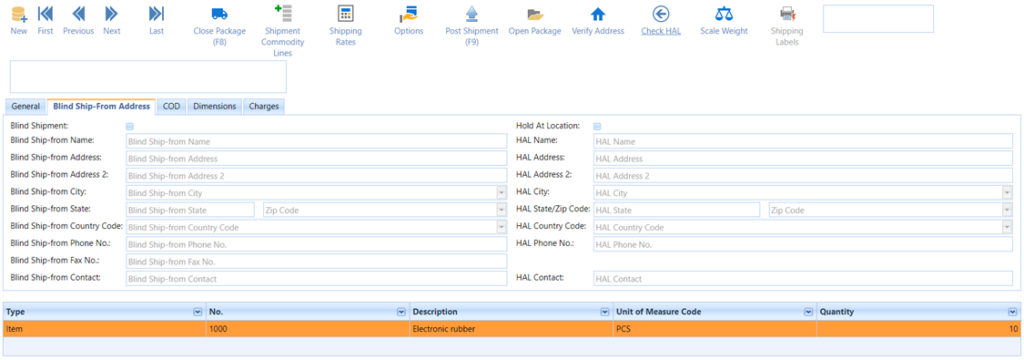
This is Blind Ship-from Tab in the Package Card form. If the user wants to display a different address on the label, he or she must select this Blind shipment option. It contains the Blind Shipping address details and contact details.
The COD Tab fields in the Package Card form:
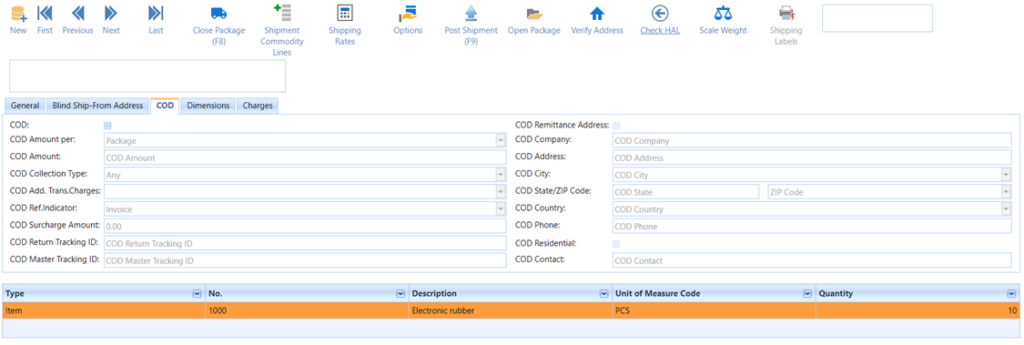
Short Description for the COD Tab Fields in Pack Order form:
| Fields | Comments |
| COD | Specifies whether the COD option is enabled or not. |
| COD Amount Per | This field is used to specify COD amount is set to package Level or Shipment Level. Valid Values are Package and Shipment |
| COD Amount | This field is used to specify the total amount to be collected for COD. |
| COD Collection Type | This is field is used to specify the collection type of COD amount. Collection Types are different for FEDEX and UPS. Valid Values for FEDEX: ANYCASHCOMPANY_CHECKGUARANTEED_FUNDSPERSONAL_CHECK Valid Values for UPS: CASHCHECKPERSONAL_CHECK |
| COD Add. Trans. Charges | This element allows you to add transportation charges to the C.O.D. collection amount. This field is an optional field when the user selects the shipping agent code as FEDEX. Valid Values are: Add. Acc. COD SurchargeAdd. Acc. Net ChargeAdd. Acc. Net FreightAdd. Acc. Total Cust. ChargeAdd. List COD SurchargeAdd. List Net ChargeAdd. List Net FreightAdd. List Total Cust. Charge |
| COD Ref. Indicator | If you want reference information added to the return C.O.D. label, use this element. This field is an optional field when the user selects the shipping agent code as FEDEX. Valid Values are: InvoicePOReferenceTracking |
| COD Surcharge Amount | This field is used to specify an extra fee, charge, or tax that is added on to the actual cost, beyond the initially quoted price. |
| COD Return Tracking ID | This field is used to specify the Return Tracking ID for the Cod service. |
| COD Master Tracking ID | This field is used to specify the Master Tracking ID for the Cod service for the Multiple packages. |
| COD Remittance Address. | Specifies whether the COD Remittance Address is enabled or not. The shipper’s address is populated by default which can be changed. |
| COD Company | Specifies the location Identification Like Company, Bank Name, etc. |
| COD Address | Specify the COD Address. It is automatically populated when the user checked the COD return Address field. |
| COD City | Specifies the COD City. It is automatically populated when the user checked the COD return Address field. |
| COD State/Zip Code | Specifies the COD Stage and Zip Code. It is automatically populated when the user checked the COD return Address field. |
| COD Country Code | Specifies the COD Country. It is automatically populated when the user checked the COD return Address field. |
| COD Phone No | Specifies the COD Phone. It is automatically populated when the user checked the COD return Address field. |
| COD Residential | Specifies whether the COD Address is residential or not. |
| COD Contact | Specifies the COD Contact person’s Name. It is automatically populated when the user checked the COD return Address field. |
The Dimension Fields in the package card are the same as the Dimension tab of the Pack Order screen with some additional fields (Actual Package value, Package Creation Information, etc.). As shown in the below screenshot: –
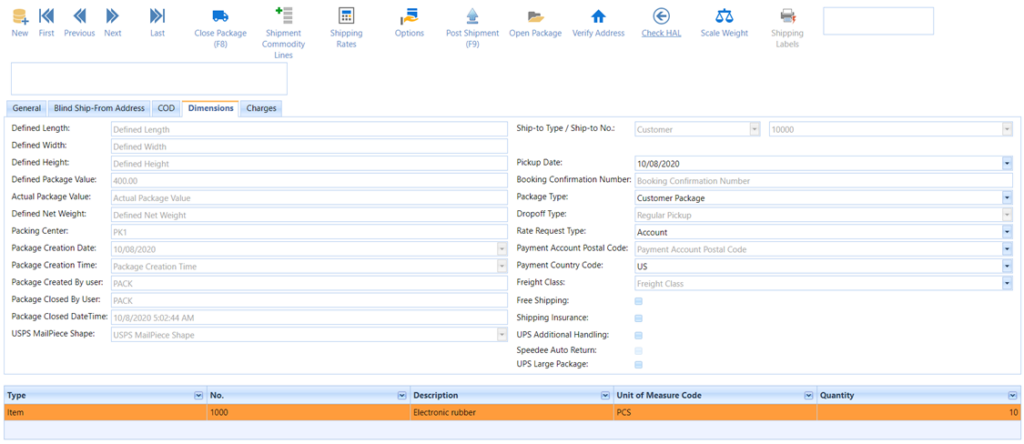
The Charges Tab Fields Show the Cost, taxes, Surcharge Tax, Shipment Weight, Billing Weight, Tracking ID related Information. These fields will be updated on this page when we close the package as shown in the below screenshot: –

Post Shipment is the last Step in the shipment process to post the Shipment Order. Click on Post Shipment or function Key F9. This means Now the Order is shipped and is ready to Invoice in Business Central.

The menu bar across the top of the Posted Packages list window displays the following elements.

With this option, we obtain the tracking information of the package for FedEx, UPS, and USPS. After getting the tracking number, the form will look similar to the screen below.


